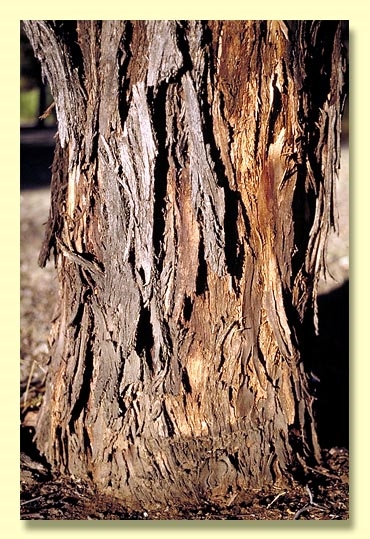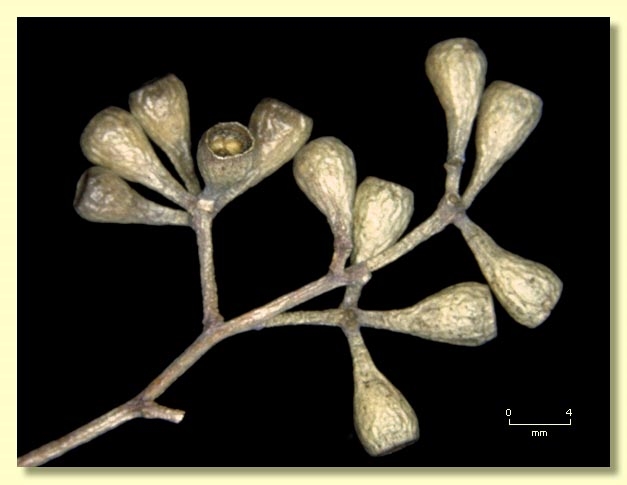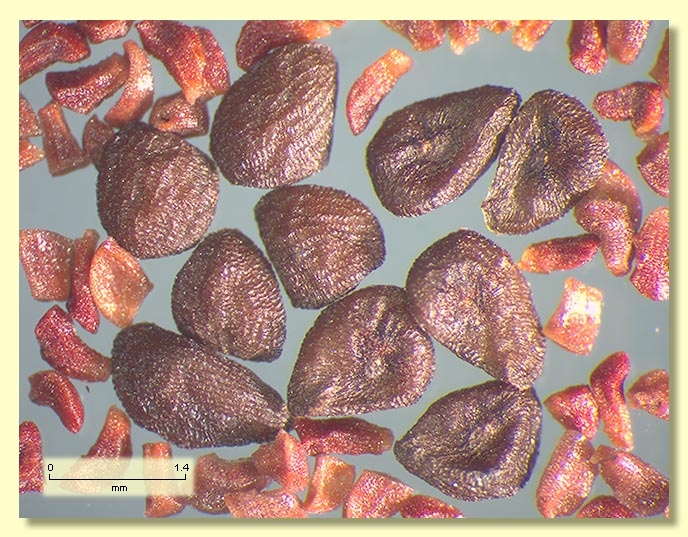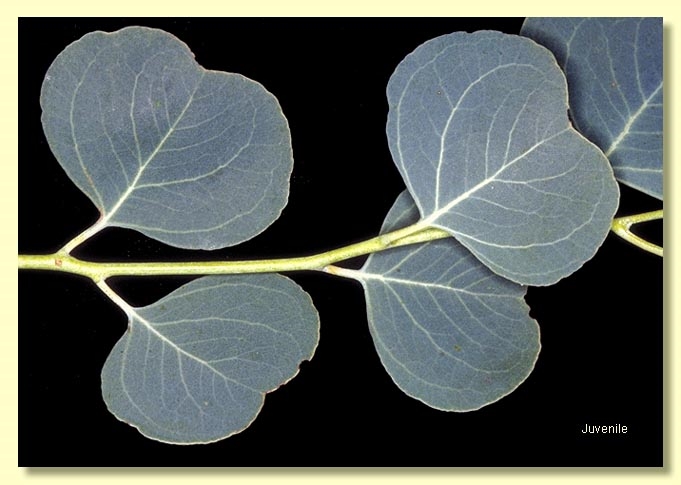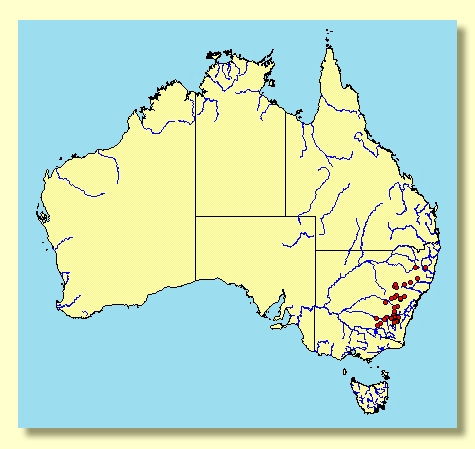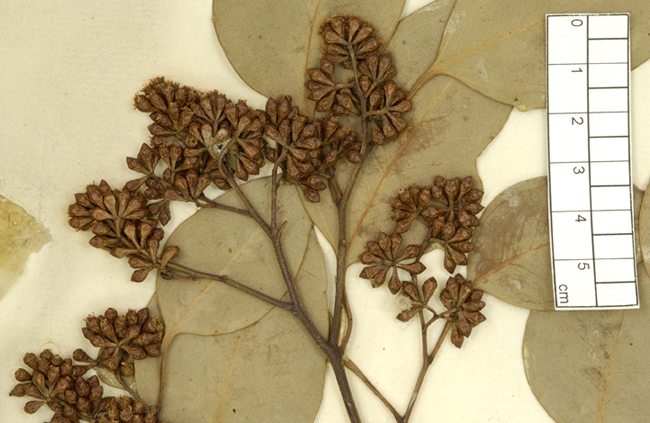Euclid - Online edition
Eucalyptus polyanthemos subsp. polyanthemos
Eucalyptus | Symphyomyrtus | Adnataria | Terminales | Heterophloiae
Eucalyptus ovalifolia var. lanceolata R.T.Baker & H.G.Sm., Res. Eucalypts 124 (1902). T: New South Wales: Camboon, N of Rylstone, 10 Oct. 1893, R.T.Baker NSW 19153; lecto: NSW.
Bark smooth throughout or with persistent flakes of rough grey bark at base of trunk only; smooth bark mottled cream, grey, white and yellow; branchlets glaucous or non-glaucous.
Juvenile growth (coppice or field seedlings to 50 cm): stem rounded in cross-section; juvenile leaves always petiolate, opposite for 4 to 6 nodes then alternate, orbicular to broadly ovate, 2.5–8 cm long, 2.5–6.5 cm wide, base truncate, rounded or tapering to petiole, apex emarginate or rounded, green to blue-grey or rarely glaucous.
Crown often of juvenile to intermediate leaves. Crown leaves alternate, petiole 1–2.7 cm long; blade lanceolate to ovate to orbicular, 5–11 cm long, 1.8–5 cm wide, base usually tapering to petiole, concolorous, dull, green to blue-grey or grey-green, or glaucous, side-veins at an acute or wider angle to midrib, densely to very densely reticulate, intramarginal vein well removed from margin and looped, oil glands obscure or intersectional.
Inflorescence terminal compound, peduncles 0.2–1 cm long, buds 7 per umbel, pedicels 0.1–0.5 cm long. Mature buds diamond-shaped to ovoid, 0.3–0.5 cm long, 0.2–0.3 cm wide, scar present, operculum conical or slightly beaked, stamens inflexed, with outer staminodes, anthers adnate, positioned obliquely at filament tip, cuboid to cuneate, dehiscing by terminal pores, style long, stigma blunt or pin-head shaped, locules 3 or 4, the placentae each with 4 vertical ovule rows. Flowers white.
Fruit on pedicels 0.1–0.4 cm long, barrel-shaped to obconical, 0.3–0.6 cm long, 0.3–0.6 cm wide, sometimes slightly glaucous, rim thin, often split, disc descending, valves 3 or 4, enclosed.
Seeds brown or grey, 0.8–1.4 mm long, ovoid or flattened-ovoid, dorsal surface shallowly pitted, hilum ventral.
Cultivated seedlings (measured at ca node 10): cotyledons reniform to oblong; stems rounded to square in cross-section, glaucous or non-glaucous; leaves always petiolate, opposite for 4 or 5 nodes then alternate, ovate to orbicular (to wider than long), 2.5–6 cm long, 2–7.5 cm wide, base truncate to tapering, margin entire, apex rounded to emarginate or pointed, dull, grey-green or glaucous or, rarely, green.
Flowering has been recorded in October and November.
In Western Australia Eucalyptus polyanthemos has escaped from plantings and become naturalised (Hussey et al., 1997).
Eucalyptus polyanthemos is a species of small to medium-sized forest or woodland tree, widespread in far south-eastern Australia from the Central Tablelands and Central Western Slopes of New South Wales to eastern and central Victoria, usually on shallow soils on rising ground. It is easily recognised by the small dull, bluish grey (rarely green in central Victoria) narrowly ovate to more or less orbicular crown leaves and orbicular to broadly ovate bluish grey to glaucous juvenile leaves, terminal inflorescences, ovoid to diamond-shaped buds, stamens inflexed in bud and obconical thin-rimmed fruit.
E. polyanthemos differs from its closest relative, E. baueriana, which has glossy leaves and has a more coastal distribution. Other box species that overlap in distribution and are likely to be confused with E. polyanthemos are E. albens, which has fusiform buds, larger, more barrel-shaped fruit and large, coarser, ovate juvenile leaves; and E. melliodora, which has axillary inflorescences and small elliptical to narrowly ovate juvenile leaves and small, more hemispherical fruit. E. microcarpa is easily distinguished from E. polyanthemos by its glossy green crown. Another box species superficially very similar to E. polyanthemos is the smooth-barked E. dawsonii from the upper Hunter Valley area of New South Wales. E. dawsonii differs in having irregularly flexed stamens in bud, all anthers fertile, and having adult leaves with intramarginal vein very close to the edge of the leaf (intramarginal vein distant and "looping" in E. polyanthemos).
There are three subspecies of red box:
E. polyanthemos subsp. polyanthemos
Has mostly smooth bark throughout, or rough bark only on the base of the trunk with smooth upper trunk and branches, and orbicular to ovate or elliptical-ovate leaves. It is widespread on the Central and Southern Tablelands of New South Wales and adjacent Western Slopes, south from Gulgong and Burrendong.
E. polyanthemos subsp. vestita
Bark rough over the whole trunk and branches and has leaves similar to subsp. polyanthemos. Subsp. vestita occurs on hills of central and eastern Victoria from east of Ararat and extends into far southern New South Wales from Albury to Bombala.
E. polyanthemos subsp. longior
A taller tree of forests in East Gippsland from near Bairnsdale east to the New South Wales – Victoria border region north-east of Cann River. Subsp. longior has rough bark and lanceolate adult leaves to 15 cm long and occurs in foothills.
In the classification of Brooker (2000) Eucalyptus polyanthemos belongs in Eucalyptus subgenus Symphyomyrtus section Adnataria because the buds have two opercula, ovules are in four rows, seeds are flattened-ovoid, cotyledons are reniform, and anthers are rigid on the staminal filaments. Within section Adnataria, E. polyanthemos is part of series Heterophloiae having box bark, terminal inflorescences, buds that shed the outer operculum early, stamens inflexed and the outer stamens sterile (staminodes). Other species in this series are E. rudderi from the Taree area of the North Coast of New South Wales, E. baueriana in southern New South Wales and eastern Victoria, E. magnificata from the northern tablelands of New South Wales and southern Queensland, E. hypostomatica north from western Sydney to Wattagan State Forest, E. conica from the slopes and adjacent tableland areas of New South Wales north from the Weddin Mountains to central Queensland, and E. fasciculosa from far western Victoria and south-eastern parts of South Australia. An eighth species in the series, E. lucens, is found only west and south-west of Alice Springs.
In 2004 Rule published another subspecies Eucalyptus polyanthemos subsp. marginalis to accomodate non-glaucous, rough-barked form of red box found in Victorian box-ironbark woodlands especially. We have found over the range of E. polyanthemos generally that glaucescence and leaf colour is variable within populations and that the erection of a new taxon on this basis is therefore unhelpful. The new name is placed in synonymy with subsp. vestita because of the rough bark.


